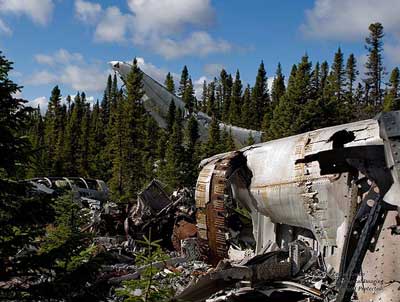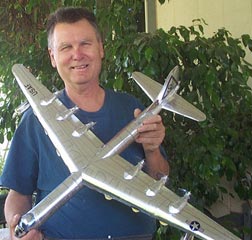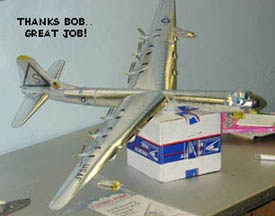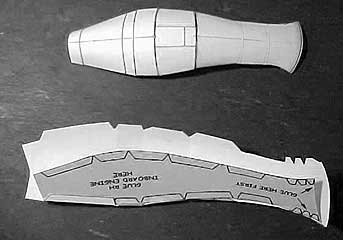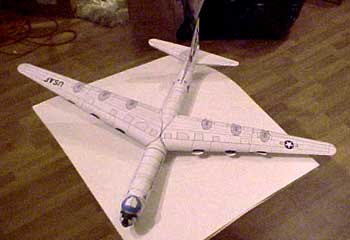


Convair B-36 Peacekeeper Bomber
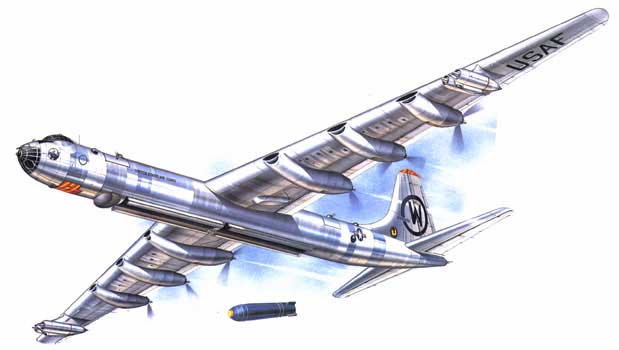
The reverberating snarl of these high-flying, monsters pervaded
much of the globe during the Cold War of the 1950s..
The largest bomber ever built was designed in 1941 and a prototype
was ordered a few days before Pearl Harbor. The aircraft (without
the 4 jet engines which were added to later models from the D version
on) flew for the first time on August 8, 1946. Because it went into
production just after the War and coincided with the appearance
of bombers completely equipped with jet engines, its production
was limited to 146 units. These formidable strategic bombers were
in service until May 1958.
Toward the end of their useful life, they were used for atomic experiments.
The B-36 folder includes the 40" span downloadable model (print
it on plain cardstock or ink jet silver paper), it includes the
MK-17 Atomic Bomb in the same scale, a page of B-36 Prop Discs,
Plus a folder of markings, should you want to build a little bevy
of Peacemakers.
: I have dug into the subject and it had
indeed been necessary to extend the F-84F plane in order
to raise or lower the gear of the B-36. The wings of the
fighter would otherwise have gotten in the way of the Big
B-36 wheels. Herbert
18 pages! Whoa... at least there isn't much ink ... Jimmy Stewart - Strategic Air Command- Nostalgia Week ,,Cam
The B-36 made it to the competition but suffered some damage in stop and go freeway traffic 39 miles and rushing from the parking lot to the Northrop building in the rain storm..Size and silver paper impressive. "That's Paper!" heard several times. Lots of B-36 comments from the old timers attending the meeting. Bob Penikas (beta builder)
..Another future "big seller" was brought in by Bob -- a "beta test" of the soon-to-be-released B-36 Peacekeeper, with a truly massive wingspan boasting 6 propeller-driven engines and four jets. Bob printed it on metallic paper and it truly deserved it's nickname of "Aluminum Overcast". I'd like to see someone try to motorize this monster! Bob mentioned that there's been at least three design changes since he began this build, but his finished work was awesome. The final released version will be fantastic.
Go Chip - !!!!! The B-36!!!!! Wow!!!!!
Incidentally, one of the Polish paper model
companies has produced a1/33rd scale model B-52 - with a
wingspan just over 6 feet! I have that model - but haven't
assembled it yet. But the 40" wingspan B-36 must certainly
rank in the top 3 biggest paper models of all time.. Mark
B (May 8) 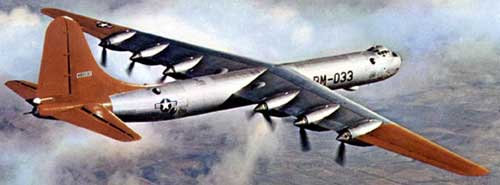
I took one look at this latest and created a separate file for it. Does the word Godzilla mean anything here?? Truly amazing. I'm phoning my stockbroker tomorrow and telling him to buy Elmer's stock...Well done Derek (May 8)
Chip, You and your little team of aviation elves have once again worked your magic! The B-36 one huge beauty! I got my Silver Paper, I got my tools!! Boohoo!!! Marc!
....Well, the B-36 model just pushed me over the edge. Got to have it, got to have it, got to have it ... I have just ordered the new update CD (all aircraft up to this very minute, I hope this includes the B-36! ) Then I decided I was through trying to remember when my magic key was up, so I included $100 for lifetime membership. In my case that probably won't amount to too many more years. But, that's ok, I figure you have more than given me enough entertainment and excitement over the years with your wonderful models. As always, Bruce (roorat)
On the B-36, finally finally a method that is working superbly...By using the 3M super multipurpose adhesive in the spray can, I laminated the silver sheets to the card stock. Then by using my fingers to curve the fuselage sections rather than a broom handle, I did not put creases in the silver. They are joining together beautifully. Also at work I picked up some C1s(Coated one side) print board and cut them down to 8 1/2 by 11 and now I am getting a slight shine to the printed models is Curtiss Robin. That seems to be working much better than the Wall Mart card stock which works well but you get no sheen. Jim Duckworth
...I downloaded the files, thanks. It's
still pretty cool to get this stuff on the same day.

On another note, I started paper models because of your models. Specifically the Colditz glider and the private planes. It seems no one else offers these planes, especially the plastic manufacturers. Just wanted to let you know how much I appreciate the more esoteric planes, and the histories behind them. Thanks! Tom
Got the plans, GREAT! You people are fantastic. However, I have over the last lifetime I spent in this world, have tried 48 million, kazillion different kinds of glue to laminate sheets of anything to anything. Spray glue ain' t worth a poop, leaves globs. Brush glue looks like a brush paint job on your car! Glue stick, lets not go there.
O. K. lets get to the punch line. I'm older than J. C. him self, go to your wife's fabric store and get "Stitch Wichery" (HTC, Inc.). This is a spider webby looking thing that is a heat activated thing, about 1.50 per yard, about 18" wide.
Cut printed item to be reinforced a little over sized, lay this on a cut piece "Stitch Wichery" even a little bit bigger. Lay this on the sheet of reinforcement card stock, on top of this lay a thin sheet of "sacrifice" paper. Set your wife's iron to about half way between "wool" and "cotton". Press, (do not scorch). Use a FIRM surface to work on. My experience has shown this to be FANTASTIC!!!
PLEASE keep up the GOOD work....Tony 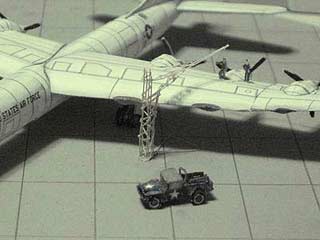
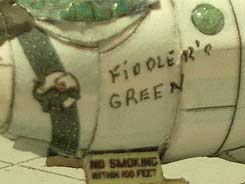
For doubling, I've found that spray adhesive works very well if you're careful about fumes and over spray (the stuff is VERY sticky). I've also had very good luck with Elmer's glue sticks -- the wide ones, about 2cm diameter. Unless you use a spray, I've found that a good rubber roller is almost essential for large areas of doubled material. I use a cheap 6" (15cm) block print roller that I picked up at my local art supply store. It gets a lot of use.
Just downloaded the B-36. Looks great and has an impossible size for people, who live in a smaller than the average American house. Even larger is FMP (FLY) 's model of the B-52 - D in 1 : 33, which has a length of 1,30 meter (51") and a wingspan of 1,70 meter (67") (sic!). Yours is the first B-36 in paper, that I have come across, though and it surely fills a gap in my collection. Congratulations on this one, keep up the good work! Maurice van Wagtendonk Netherlands..
You are right Chip. They were all in the bone yard at Davis-Monthan, by Vietnam. I had a good friend who started his AF career as a crew chief on a B-36, and of course, they flew on the aircraft since they could go in the wings and work on the engines if necessary. I remember once reading that a B-36 from Waco, TX had made an emergency landing, during a routine training mission, at RAF Fairford!
One other funny: A SAC General taking a familiarization flight on a B-36, was impressed that a very young, second Lieutenant was in the co-pilots position (of course, they always had at least two full crews) The General said, "Do you get to fly much Lt.?" And the Lt. replied, yessir, I get to fly east in the mornings and west in the afternoons!" That was quite an airplane. They built 2, C-99 cargo versions, and it was a very good airplane. They were at Kelly AFB, in San Antonio, and I use to see them take off all the time when I was in pre-flight at Lackland, in 1954. I guess they really earned their keep in those days. BoB
I am having super success with the B-36, only thing now is to locate some wheels of the right size..I can't find O rings of the right thickness so I may have to rob a toy car or something....JD
i have completed the b-36 .i stayed up till one last night finishing the engines i took it to school to show it off and got many complements and of course the idiots who say stupid stuff about how waste my time on stupid airplanes well all i have to say is id rather be doing this than drugs....my principle asked if he could put it in the trophy case and i told him yes my 8th grade graduation is coming up on the 19th so everyone will see it... sincerely,,,ethan mcmillin
... all I can say is WOW and so did my
wife when I printed it out and saw how big it is going to
be when done. I even played around and colored some of the
parts to make the red wing and tailed version. Best Regards,
Jeff 
....the Thunderflash's horizontal stabilizers tilted down at an angle to fit inside the B-36's bomb bay. Even the Thunderstreak when used as a FICON had down-tilted stabilizers. Therefore Chip's F-84 would need to be altered to be used with the B-36. I find it hard to believe he missed this on the model. Personally, I won't be building an F-84 to accompany my B-36 Peacemaker until Fiddler's Green makes an RF-84K Thunderflash ..." roorat
The B-36 is really great! It has always
been my favorite military aircraft. I actually saw one of
those flying behemoths way back in the mid-fifties
when there was considerably more military air traffic in
this neck of the woods, as this part of New England played
host to several Navy and Air
Force installations.It was a sight I never forgot! At any
rate I am a VERY SATISFIED customer!!!
Thank you again for your patience! Appreciatively, Charles
E York
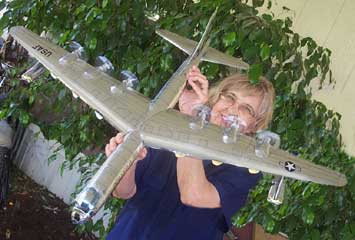
Annie is pretty much overwhelmed by the model's awesomeness. We had to build this three times to figure out the best possible design and Annie actually had a 1/2" blister on her thumb from all the cutting out.. Many thanks to Bob Penikas, Jim Duckworth, and Anthony Schanchez for building the BETA versions.

The XB-35/YB-49 had some stability problems however, and were quite a radical design for the time. With no long tail to stabilize and help turn, the flying wing looked more like a boomerang than an aircraft. So, because of this and the usual dose of "politics," the powers that be went with the XB-36. The first flight was on August 8, 1946.
The XB was developed with a nine-foot, two-inch single tire on each main gear, the largest aircraft tire ever produced. With this very heavy footprint, there were only three U.S. airfields with the 22 1/2 inch thick runways that were needed to support this heavy bomber. They were located at Carswell AFB, Texas; Eglin AFB, Florida; and Fairfield-Suisun (renamed Travis AFB), California. This single tire setup was soon discarded, and the twin-doubles developed. These proved much more effective. With more rubber on the pavement, a runway only 13 1/2 inches thick was required. This made 22 primary and 22 alternate fields available.
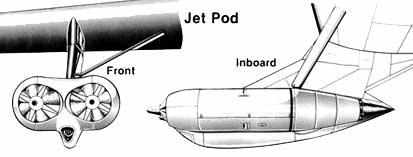
Modifications were made to the 22 "A" models, changing them into "B" models. Seventy-two more "B"s were produced, following its first flight on July 8, 1948. Changes were made in the R-4360 engines, upping the horsepower to 3,500 each. This gave a service ceiling of 42,000 feet and a top speed of 381 mph. Performance data now used was based on "combat weight"(expected weight over the target, not take-off weight). This computing method raised the "A"model to a speed of 345 mph and gave a service ceiling increase from 31,600 to 39,100 feet.
|
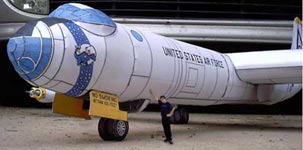
|
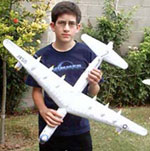
|
Then, more changes were made, and soon the "D"- model followed. It had more engine improvements and the addition of a single pod containing two General Electric J-47-GE-l9 engines under each wing. This gave a top speed of 439 mph with a service ceiling of 45,200 feet. Gross weight went to 357,500 lbs, cruising speed to 225, and it could carry a 10,000 lb load for 7,500 miles. Seventy one of the "B"s were modified to the "D" configuration. Landing speed remained a respectful 121 mph. The first operational B-36 aircraft was delivered to the 7th Bomb Wing 1BW) at Carswell AFB, Ft Worth, Texas, on June 26, 1948. When production ended in August, 1954, 385 of these powerful aircraft had been produced at a cost of $3.6 million each.
The statistics on this plane are still very impressive. Wing span was 230 feet. It was 162 feet long, had a tail that towered to 46 ft 10 in, the wing area was 4,772 sq ft. The bomber had a fuel capacity of 32,910 gallons and engine oil capacity of 1,200 gallons. A crew of from 12 to 15 was needed to man all positions. Armament was eight remotely operated turrets with dual 20mm cannons in each. Each cannon had 600 rounds of ammunition available except for the nose position which had 400 rounds. All turrets, except the nose and tail turrets, retracted into the aircraft.
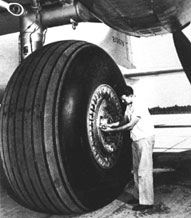 Later, the "J" model came into being. All non-essential and
crew comfort items were removed along with other weight reducing measures.
This decreased the basic weight, making the performance of the "J"
model even more impressive. It had a gross weight of 410,000 lbs, cruise
speed of 230 mph, and a max speed of 430 mph. Range was 8,300 statute
miles with a service ceiling of 46,800 feet. On this model, all guns were
removed except for two M-24, 20mm cannons in the tail.
Later, the "J" model came into being. All non-essential and
crew comfort items were removed along with other weight reducing measures.
This decreased the basic weight, making the performance of the "J"
model even more impressive. It had a gross weight of 410,000 lbs, cruise
speed of 230 mph, and a max speed of 430 mph. Range was 8,300 statute
miles with a service ceiling of 46,800 feet. On this model, all guns were
removed except for two M-24, 20mm cannons in the tail.
Although the new bomber was interesting and fun to fly, it had one rather
naughty problem that gave the maintenance men a real fit. It wouldn't
hold its gas. That's right...it was plagued with gas leaks. It didn't
take long to become evident that this was a problem that could not be
fixed by on-base band-aids. It would require something more drastic. So,
after having them for less than a year, B-36s were returned to the company
to fix their leak problems.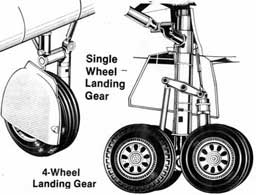
Here is other trivia data that really impressed all who qualified to fly this bird. The wing was more than seven feet thick at the root. A person could climb into the wing and work his way outboard of the center engine. The 19 ft square tipped props were geared to turn approximately one half engine speed to keep them sub-sonic, which gave that unforgettable throbbing. Each aircraft used 336 sparkplug's, a big portion of which required replacing after each mission. The engineer's station had an engine "analyzer" which was used periodically in flight to determine engine condition. Each engine carried its own oil supply of 150 gallons which was not enough in some cases. The aircraft had four bomb bays, which could be configured to carry up to 72,000 lbs of bombs.
The NB-36H was modified and used as an atomic reactor test bed. This
aircraft was operated by normal means, however, while testing was going
on. This propulsion idea did not prove out and was discarded, but it was
the only plane to have so served. Other aircraft were configured to carry
fighter planes. The McDonnell XF-85 "Goblin," a fighter with
folding wings, was developed to be carried in the rear bomb bay but was
never actually tested with the B-36. Tests were also made with the RF-84F,
carrying, deploying and recovering it using a trapeze hook-up under the
aircraft. They also tested the "TomTom" wing-tip setup which
was to carry an RF-84F on each wing tip. This 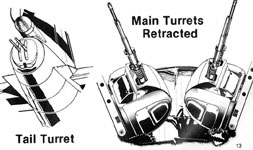 was discarded when it was
found that the intense wing tip vortices made hook-up nearly impossible.
Plus, the fighter pilot was trapped in his aircraft for the entire flight.
None of these projects proved feasible, and all were abandoned.
was discarded when it was
found that the intense wing tip vortices made hook-up nearly impossible.
Plus, the fighter pilot was trapped in his aircraft for the entire flight.
None of these projects proved feasible, and all were abandoned.
There are four B-36s still intact and on display. The last one to fly is located at the Air Force Museum at Wright Patterson AFB, Ohio. The last one built, which is also the last to carry the SAC (Strategic Air Command) emblem is located at the General Dynamics plant in Ft Worth, Texas. A "J" model is on display at Moffett AFB, Nebraska, and a B-36H is on display at Castle AFB, California.
From article by Col (Ret) Francis H Potter
Development of America's present-day jet-bomber force began as far back as 1941 when it appeared that Hitler was about to take over the whole of Western Europe, and it seemed possible that the United States might have to make a stand from its own bases if she hoped to strike enemy targets in Europe. For this task a strategic bomber that could carry a 10,000-pound load over a distance of 5000 miles to its objective and return to its North American base without refueling, would be necessary. Furthermore, it would have to fly at 35,000 feet at a speed somewhere between 240-300 miles per hour.
|
|
 We've really tried hard to keep these engines authentic while being easy to build,, Please read the instructions and notes on the sheets to become familiar with the model. Remember, you can always print another copy when you mess up the first.. are digital models great or what?! |
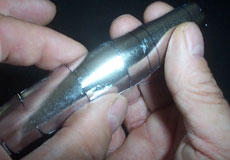 Be sure to carefully PRE-bend the engines before gluing them to the wings |
|
|
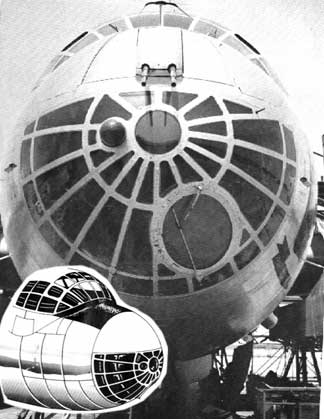
These specifications were distributed quietly, and from four designs submitted the one offered by the Consolidated Aircraft Company was selected. This giant machine, the biggest that would go into service with the Army Air Force, was to have a wing span of 230 feet, a pressurized fuselage, six piston engines with pusher propellers behind the trailing edge, and a gross weight of 278,000 pounds. (The Flying Fortress of that period tipped the scales at 32,700 pounds. )
Two prototypes from the original blueprints were ordered, but the building of them was assigned to the Convair factory at Forth Worth, which at the time was turning out B-32 Dominators and B-24s. By 1943 it was apparent that a strategic bomber of high performance would be necessary if Japan was to be attacked from American bases-for the concept of island-hopping had not come up---and production on the B-36 went into high gear.
The first basic model, the XV-36, came out of the shed on September 8, 1945, but did not actually fly until August 8, 1946, and by then the tail assembly had been changed from twin fins and rudders to a single fin and rudder, and a temporary armament system had been built in. The wings at their roots were six feet thick which allowed access to the Pratt & Whitney R-4360 radial engines during flight. The forward and rear compartments of the fuselage were connected by an eighty-foot tunnel along which a wheeled flatcar ran back and forth for the convenience of the crew.
Then began a long, bitter period of inter service rivalry in which the B-36 became the chief pawn. The first production aircraft was flown on August 28, 1947, and with that twenty-two B-36A machines were delivered to the Strategic Air Command. They carried no armament, but were used mainly for pilot and crew training. Not until July 8, 1948, was a B-36B, complete with six retractable and remotely controlled turrets each mounting two 20-millimeter cannon in the fuselage with two more like weapons each in the nose and tail turrets, available. The engines were still Pratt & Whitney radials, and by now the weight had gone up to 328,000 pounds.
Later models offered a much improved armament system, and the bays were modified to take two 42,000-pound bombs, and the new K-3A bombing-navigation system was installed as well as gun-laying radar. In some models the radials were replaced by four Allison J35 jets, and these were in turn replaced by General Electric J47 turbojets. With the new B-36 SAC had entered the giant, jet-propelled bomber sweepstakes.
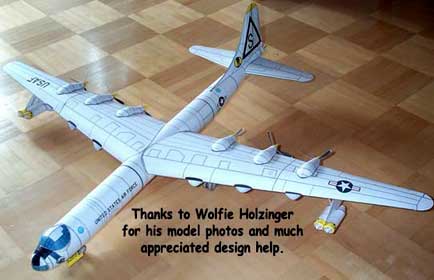 |
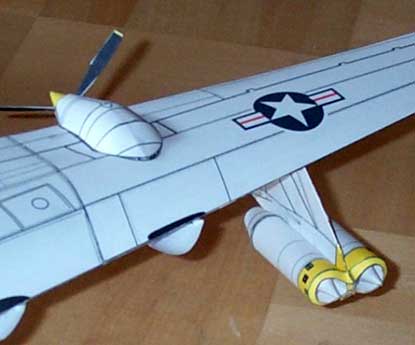 |
Week after week saw broad modifications in the monster. Some were produced as strategic reconnaissance planes in which two of the bomb bays were turned into photo areas that mounted fourteen cameras. It was obvious no one knew what classification to aim for next.
The RB-36D was revised to develop the parasite-fighter theory, then known as FICON (Fighter-Conveyor). In this a McDonnell XF-85 was slung under the fuselage, taken into the air and released at a specified time, or over a specified area, but this first experiment was soon abandoned, and the Republic GRF-84, an F-84 modified for release from a trapeze gear, was substituted. It seems that in this there was some hope of stretching the range of any contemporary fighter-an aircraft carrier of the air, so to speak.
Final production versions of the B-36J, now weighing 410,000 pounds, were built in the spring of 1952, and by that time all piston-engine B-36s were retired. About eighty of the final model were assembled and shipped out to various squadrons. The 92nd Bomb Wing took them out to Guam. The 11th Bomb Wing had them in North Africa, and a few saw temporary service in Great Britain on training missions.
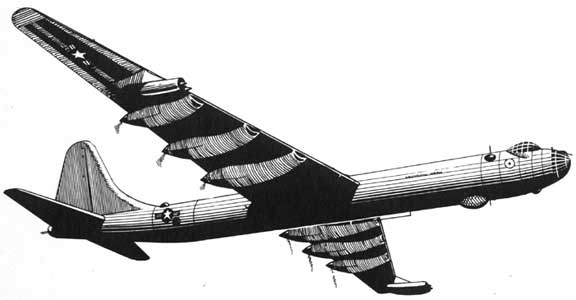 By this time the B-36 had proved itself in many ways-that
is as a peacetime bomber-and it had eluded United States interceptors
in defense exercises since it could hide at extreme altitude, up to 45,000
feet, a ceiling made possible by its moderate wing-loading and high aspect
ratio. There, of course, were questions whether this immunity would have
lasted very long against the lightweight Russian MiG that first appeared
in 1948, or the eventual improvement in Russian radar interception.
By this time the B-36 had proved itself in many ways-that
is as a peacetime bomber-and it had eluded United States interceptors
in defense exercises since it could hide at extreme altitude, up to 45,000
feet, a ceiling made possible by its moderate wing-loading and high aspect
ratio. There, of course, were questions whether this immunity would have
lasted very long against the lightweight Russian MiG that first appeared
in 1948, or the eventual improvement in Russian radar interception.
In 1955 one B-36H was modified to become a test bed for a nuclear reactor, but in its first flights the reactor did not contribute to the propulsion. It was mounted to check the effect of radiation upon instruments, equipment, and airframe, and to develop certain shielding methods. What resulted from this study has not been divulged, but a B-36 that was to use nuclear power for primary propulsion was eventually abandoned.
The B-36 was a costly venture, but it must have contributed something to the deof the SAC strategic-bomber force. Except for the ill-fated B-70 project, nothing of its size or program of development has been undertaken since, for, as will be seen, modern strategic bombers are little more than fighter-bomber types with a wide capability.
The RB-36 models had 14 cameras in place of two of the four weapon bays and a crew increased from 15 to 22.
Technical problems were severe and until 1951 reliability was poor.
In 1944-49 it was planned to carry the tiny egg shaped McDonnell F-85
Goblin jet (see FG Weird Aircraft Collection) fighter inside the forward bomb bay for added defense.
In 1953 FICON trials were held to carry and launch F 84F manned reconnaissance fighters. Some of the final examples of the 385 B-36s built were stripped of most armament and used for very long range high altitude, reconnaissance carrying large quantities of ECM and other special sensing systems.
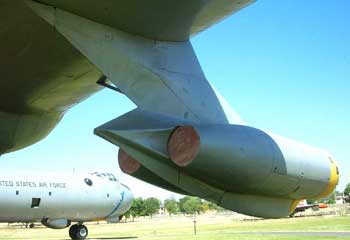 |
|
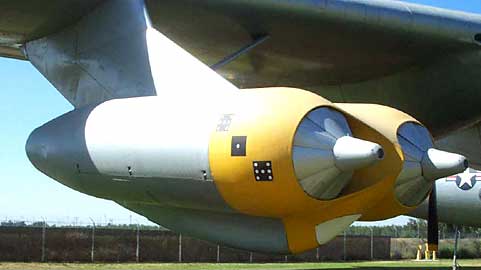 |
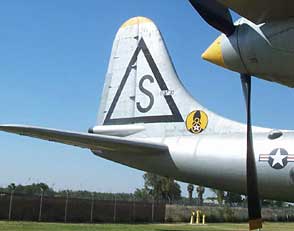 |
| The B-36's primary mission was intercontinental nuclear strikes deep within the Soviet Union for which it carried the monster Mk 17 Hydrogen thermonuclear bomb. The MK17 was 24 feet 8 inches long, 61.4 inches in diameter, and weighed between 41,400 and 42,000 lbs.; much of this was casing weight. The MK17 bomb was only four feet shorter than a POLARIS A-1 SLBM, but weighed half again as much. Approx 200 were made. | 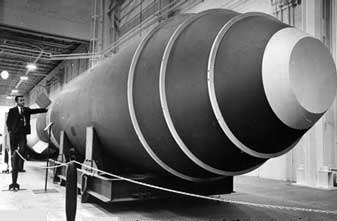 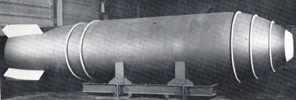 |
In addition, the requirement for cumbersome, specialized, and expensive
handling equipment doomed weapons such as the MK17 to short service lives.
These bombs could only be moved with straddle loaders or large cranes,
and were not compatible with more standardized Air Force weapons handling
equipment. They also could not be carried easily by the B-47 or B-52.
The bomb casing was made of 3 1/2" thick aluminum with a lead and
plastic liner to withstand internal explosive forces for as long as possible
and to generate compressive plasma for the secondary. MK17 yield was on
the order of 15 to 20 megatons, one of the most powerful nuclear weapons
ever built by the U.S. The bomb could be carried effectively only
by the B-36 aircraft; when the weapon was dropped, the delivery airplane
usually leaped upwards several hundred feet due to the enormous weight
loss. As an example of the handling difficulties associated with the MK17,
in early 1955 a MK17 Mod1 training weapon was assembled at Manzano for
carriage by a B-36 to Bossier Base, Louisiana because the latter site
had no railhead capable of unloading the MK17 weapon case.
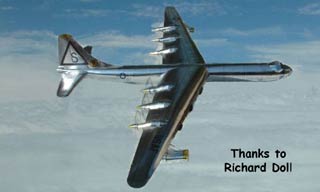
A "Broken Arrow" nuclear weapons accident
involving a MK17 occurred on May 22, 1957 when a B-36 crewman inadvertently
leaned against a release mechanism that dropped an unarmed MK17 (the "nuclear
capsule" for the primary was not installed) through closed bomb bay
doors and on to the desert in New Mexico near Kirtland Air Force Base.
The heavy explosive in the bomb exploded on impact, killing an unfortunate
cow and digging a crater 12 feet deep and 25 feet in diameter. Everyone
on the plane knew when the bomb fell: the B-36 jumped up a thousand feet.
The MK17s were retired from the stockpile between November 1956 and August 1957. It was withdrawn in favor of the MK 36 bomb, which was significantly smaller and lighter and featured a lower yield. A shift in U.S. targeting strategy from cities to military targets, along with a significant increase in the number of nuclear-capable SAC bombers, allowed the production and stockpiling of large numbers of relatively-low yield bombs in the place of a small number of high-yield bombs." *
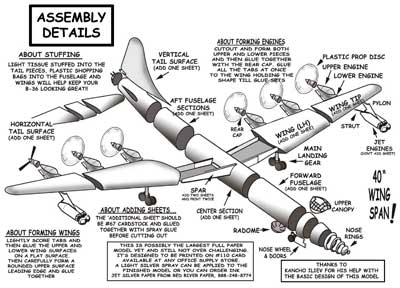
Specifications for the Convair B-36 Peacekeeper
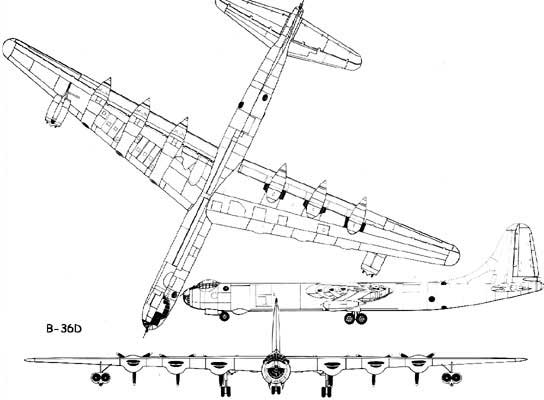 |
Crew: 9 Length: 162 ft 1 in Wingspan: 230 ft Height: 46 ft 9 in Wing area: 4,772 ft² Airfoil: NACA 63(420)-422 root, NACA 63(420)-517 tip Empty weight: 171,035 lb Loaded weight: 266,100 lb Max takeoff weight: 410,000 lb Powerplant: 4× General Electric J47 turbojets, 5,200 lbf each 6× Pratt & Whitney R-4360-53 "Wasp Major" radials, 3,800 hp each Performance Maximum speed: 420 mph with jets on Cruise speed: 230 mph with jets off Range: 6,795 mi with 10,000 lb payload Ferry range: 10,000 mi Service ceiling: 48,000 ft Rate of climb: 1,920 ft/min Wing loading: 55.76 lb/ft² Power/mass (prop): 0.086 hp/lb Thrust/weight (jet): 0.078 Armament Guns: 2× 20 mm (0.787 in) M24A1 autocannons Bombs: 86,000 lb with weight restrictions, 72,000 lb normal |
 |
|
| A: To give the huge bomber an extra burst of speed over the target area, the B-36 was fitted with four J47 turbojets to augment the six huge piston engines driving the propellers. | B: The aircraft carried by the GRB-36 was the Republic GRF-84F, a special version of the U.S. Air Force's main tactical camera ship. |
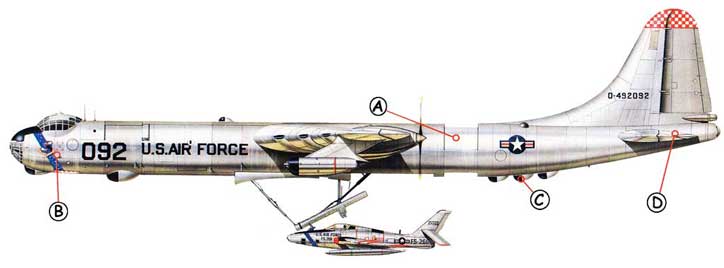 |
|||
| A: Operational bombers had two pairs of gun turrets in the rear fuselage, operated remotely from observation posts by dedicated gunners. When not threatened by the enemy, the guns were retracted and covered by sliding panels. | B: The FICON combination went operational in 1955, but only a handful of missions were flown. The operating unit was the 91st Strategic Reconnaissance Squadron. | C: The B-36 was covered with antennas and radomes for electronic equipment and bombing radars. Many variants had huge reconnaissance cameras wedged into the bomb bays. | D: B-36s were normally festooned with defensive guns. The standard bomber featured no less than 16 20-mm cannon, including two in the tail. The FICON aircraft had them all removed to save precious weight |
